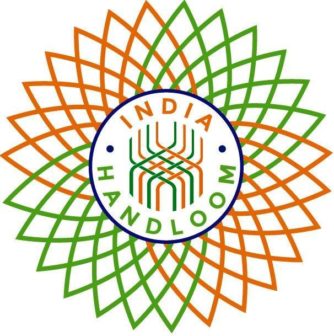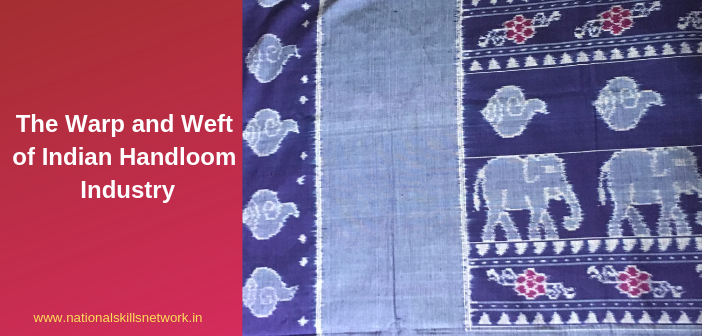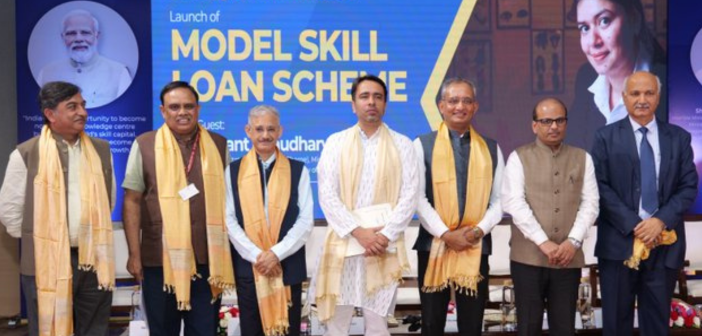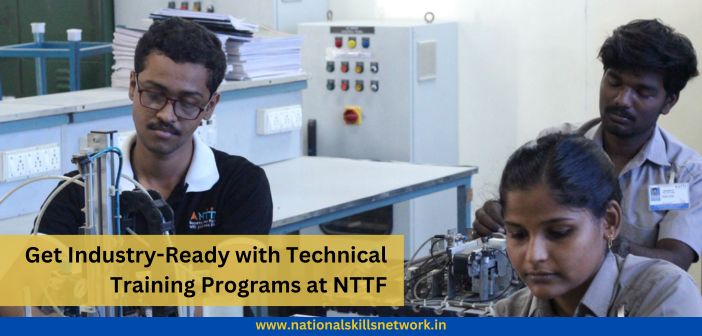The Indian Handloom industry is one of the oldest sources of sustainable livelihood for millions, being the second largest industry after agriculture. It has a significant impact at rural and semi-urban job creation with the twin benefits of protecting the richness of our heritage, textile art and craft. It employs over 4.3 million people directly and indirectly in about 2.4 million looms across India (Source: IBEF)
 The Ministry of Textiles has undertaken several measures to ensure the growth and prosperity of the industry through many schemes and interventions for the weavers and the weaving communities in across many handloom clusters. Every year 7th August is being celebrated as National Handloom Day. Let’s look the warp and weft of institutions and organizations that are integral to the industry in entrepreneurship, capacity building through skill development and higher education.
The Ministry of Textiles has undertaken several measures to ensure the growth and prosperity of the industry through many schemes and interventions for the weavers and the weaving communities in across many handloom clusters. Every year 7th August is being celebrated as National Handloom Day. Let’s look the warp and weft of institutions and organizations that are integral to the industry in entrepreneurship, capacity building through skill development and higher education.
National Handloom Development Corporation Limited (NHDC)
Ever since it was set up in 1983, National Handloom Development Corporation Limited (NHDC) has been working towards inclusive and sustainable growth of Handloom sector in India. NHDC was formed under the Ministry of Textiles, Govt. of India to address the need for a national level agency to assist the speedy development of the handloom sector with the help of 09 Regional Offices and 37 Branch offices.
NHDC has adopted a flexible and holistic approach to meet the challenges of domestic, global expansion of overall Handloom market through strategic approach to facilitate the raw material supply to the weavers of the country.
Handloom schemes and clusters under Ministry of Textiles: The Development Commissioner of Handlooms under this Ministry of Textiles is dedicated to developing a strong, vibrant Handloom Sector to provide sustainable employment to Handloom weavers. Many initiatives such as Handloom schemes and cluster based development along with interventions in identifying markets and export potential form a part of their mission.
Handloom Schemes and Handloom Clusters
Click the link to know more about Handloom Schemes: http://handlooms.nic.in/User_Panel/UserView.aspx?TypeID=1194
Click the link to know more about Handloom Clusters: http://handlooms.nic.in/User_Panel/UserView.aspx?TypeID=1242
 Development Commissioner for Handlooms
Development Commissioner for Handlooms
The office of the Development Commissioner for Handlooms was set up in 1975 under the Ministry of Commerce, however currently it functions under the Ministry of Textiles. The office administers various schemes and functions to promote the development and export of handicrafts, and supplements the efforts of State Governments by implementing various developmental schemes. It has six regional offices at Mumbai, Kolkata, Lucknow, Chennai, Guwahati, and New Delhi.
The office comprises 28 Weavers’ Service Centers (WSC) that play an important role in skilling and upskilling, capacity building and disseminating the technological interventions for reducing the drudgery to the handloom weavers and better productivity, thereby improving earning of the weavers. They provide design input to the weavers through their designers, arrange training programmes for the weavers in various pre weaving , weaving and post weaving disciplines such as winding, warping, sizing dyeing, dobby jacquard pneumatic weaving, design making (CAD), dyeing, etc. WSCs also sponsor weavers in various trade fairs, Expos, to help them in establishing direct market linkages.
Skill development and vocation training in Handlooms
The Textile Sector Skill Council (TSSC) has designed the outcome-based curriculum and training methodology for Handloom sector for job roles in designing, weaving, maintaining the loom and most importantly, being an entrepreneur. The Qualification Packs (QPs) and National Occupational Standards (NOS) are compliant with National Skills Qualification Framework (NSQF)
Higher Education in Handlooms: Indian Institutes of Handloom Technology (IIHTs)
Indian Institutes of Handloom Technology (IIHTs) are government-run institutes. There are a total of 10 such institutes across the country, out of which 6 are run by the Ministry of Textiles, Government of India and 4 are state-run Institutes.
The centre-run institutes are located across the country in locations like Varanasi, Salem, Guwahati, Jodhpur, Bargarh and Fulia.
State-run IIHTs are located in Venkatagiri, Gadag, Champa and Kannur.
Courses offered by IIHTs:
All the IIHTs run a three-year Diploma course in Handloom and Textile Technology. Whereas the institutes in Varanasi and Salem also offer a one and half year Post Diploma course in Textile Processing. A 4-year B.Tech programme in Handloom and Textile Technology is also run by the Indian Institute of Handloom Technology in Salem.
Other institutions of eminence in Handloom training and education:
Woman Weave, Maheshwar: http://www.womenweave.org/
The Handloom School, Maheshwar: http://www.thehandloomschool.org/
Government of Assam: Handloom textiles and sericulture: https://hts.assam.gov.in/how-to/get-training
Handloom Training Institute Meghalaya: http://northgarohills.gov.in/docs/htc.html
Handloom in Odisha, list of resources: https://handloom.odisha.gov.in/PDF/6_SUTS.pdf
We hope the resources shared in this article have been helpful to you. Do let us know if you wish to share information and stories pertaining to handloom on our portal. Write to us at contact@nationalskillsnetwork.com












